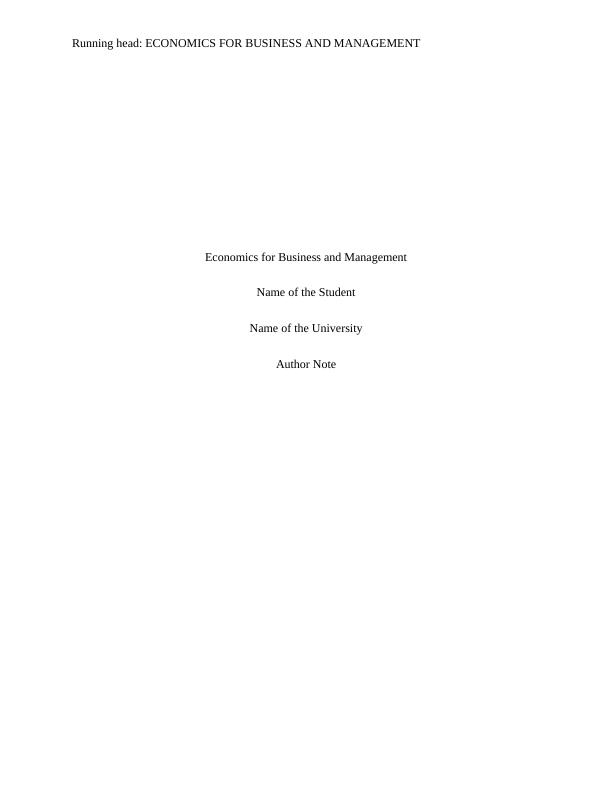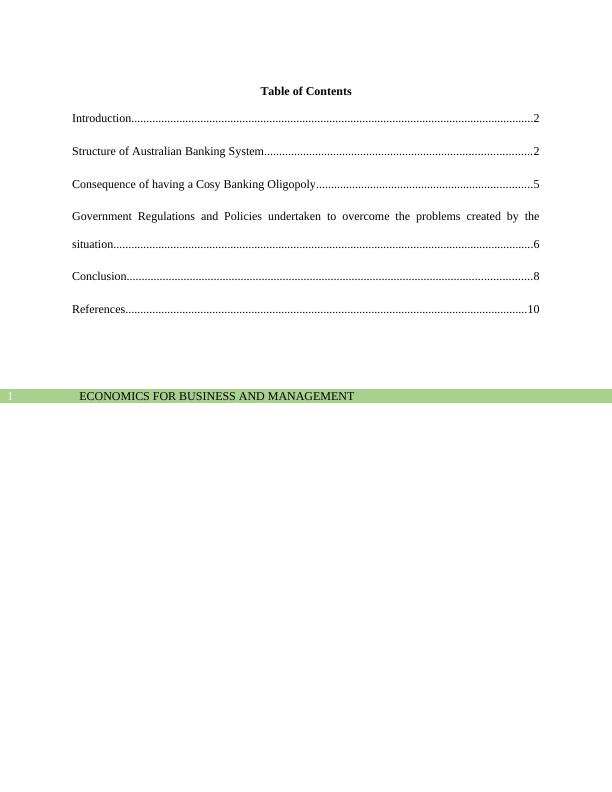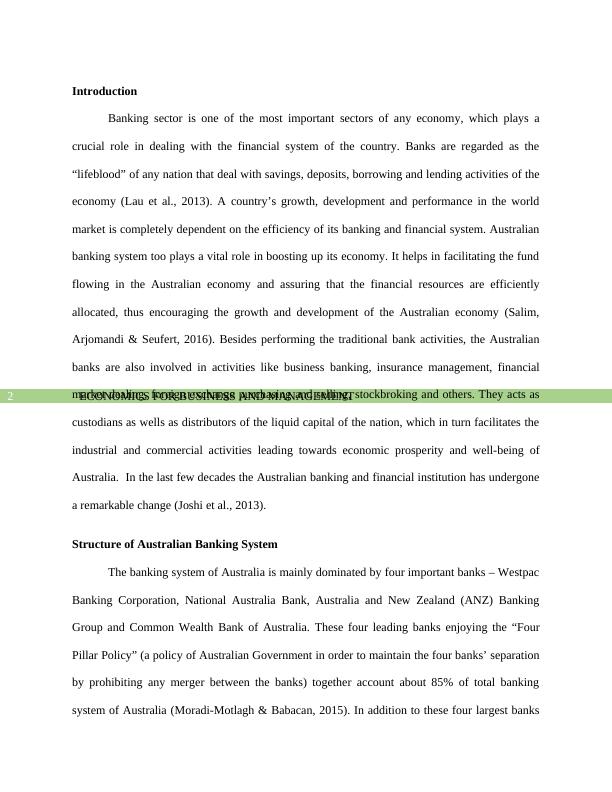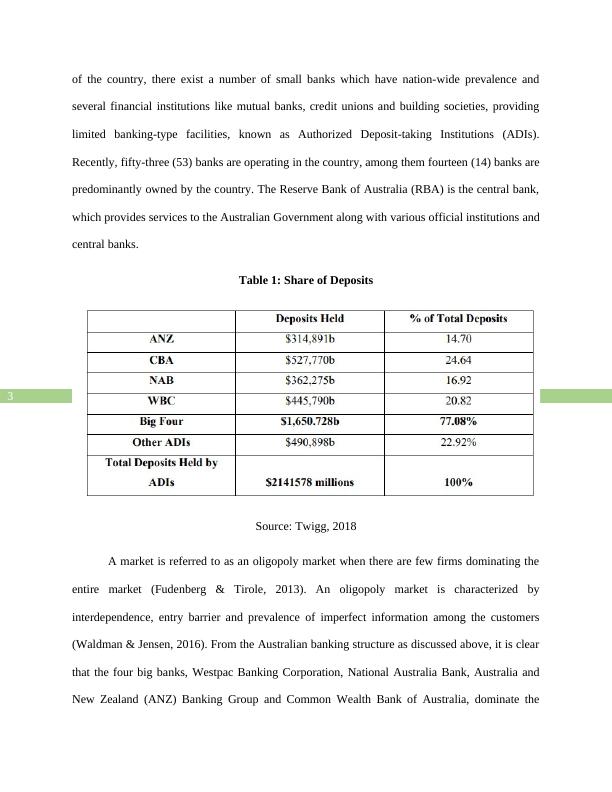Economics For Business And Management
Added on 2022-09-14
12 Pages2690 Words13 Views
Running head: ECONOMICS FOR BUSINESS AND MANAGEMENT
Economics for Business and Management
Name of the Student
Name of the University
Author Note
Economics for Business and Management
Name of the Student
Name of the University
Author Note

ECONOMICS FOR BUSINESS AND MANAGEMENT1
Table of Contents
Introduction......................................................................................................................................2
Structure of Australian Banking System.........................................................................................2
Consequence of having a Cosy Banking Oligopoly........................................................................5
Government Regulations and Policies undertaken to overcome the problems created by the
situation............................................................................................................................................6
Conclusion.......................................................................................................................................8
References......................................................................................................................................10
Table of Contents
Introduction......................................................................................................................................2
Structure of Australian Banking System.........................................................................................2
Consequence of having a Cosy Banking Oligopoly........................................................................5
Government Regulations and Policies undertaken to overcome the problems created by the
situation............................................................................................................................................6
Conclusion.......................................................................................................................................8
References......................................................................................................................................10

ECONOMICS FOR BUSINESS AND MANAGEMENT2
Introduction
Banking sector is one of the most important sectors of any economy, which plays a
crucial role in dealing with the financial system of the country. Banks are regarded as the
“lifeblood” of any nation that deal with savings, deposits, borrowing and lending activities of the
economy (Lau et al., 2013). A country’s growth, development and performance in the world
market is completely dependent on the efficiency of its banking and financial system. Australian
banking system too plays a vital role in boosting up its economy. It helps in facilitating the fund
flowing in the Australian economy and assuring that the financial resources are efficiently
allocated, thus encouraging the growth and development of the Australian economy (Salim,
Arjomandi & Seufert, 2016). Besides performing the traditional bank activities, the Australian
banks are also involved in activities like business banking, insurance management, financial
market dealing, foreign exchange purchasing and selling, stockbroking and others. They acts as
custodians as wells as distributors of the liquid capital of the nation, which in turn facilitates the
industrial and commercial activities leading towards economic prosperity and well-being of
Australia. In the last few decades the Australian banking and financial institution has undergone
a remarkable change (Joshi et al., 2013).
Structure of Australian Banking System
The banking system of Australia is mainly dominated by four important banks – Westpac
Banking Corporation, National Australia Bank, Australia and New Zealand (ANZ) Banking
Group and Common Wealth Bank of Australia. These four leading banks enjoying the “Four
Pillar Policy” (a policy of Australian Government in order to maintain the four banks’ separation
by prohibiting any merger between the banks) together account about 85% of total banking
system of Australia (Moradi-Motlagh & Babacan, 2015). In addition to these four largest banks
Introduction
Banking sector is one of the most important sectors of any economy, which plays a
crucial role in dealing with the financial system of the country. Banks are regarded as the
“lifeblood” of any nation that deal with savings, deposits, borrowing and lending activities of the
economy (Lau et al., 2013). A country’s growth, development and performance in the world
market is completely dependent on the efficiency of its banking and financial system. Australian
banking system too plays a vital role in boosting up its economy. It helps in facilitating the fund
flowing in the Australian economy and assuring that the financial resources are efficiently
allocated, thus encouraging the growth and development of the Australian economy (Salim,
Arjomandi & Seufert, 2016). Besides performing the traditional bank activities, the Australian
banks are also involved in activities like business banking, insurance management, financial
market dealing, foreign exchange purchasing and selling, stockbroking and others. They acts as
custodians as wells as distributors of the liquid capital of the nation, which in turn facilitates the
industrial and commercial activities leading towards economic prosperity and well-being of
Australia. In the last few decades the Australian banking and financial institution has undergone
a remarkable change (Joshi et al., 2013).
Structure of Australian Banking System
The banking system of Australia is mainly dominated by four important banks – Westpac
Banking Corporation, National Australia Bank, Australia and New Zealand (ANZ) Banking
Group and Common Wealth Bank of Australia. These four leading banks enjoying the “Four
Pillar Policy” (a policy of Australian Government in order to maintain the four banks’ separation
by prohibiting any merger between the banks) together account about 85% of total banking
system of Australia (Moradi-Motlagh & Babacan, 2015). In addition to these four largest banks

ECONOMICS FOR BUSINESS AND MANAGEMENT3
of the country, there exist a number of small banks which have nation-wide prevalence and
several financial institutions like mutual banks, credit unions and building societies, providing
limited banking-type facilities, known as Authorized Deposit-taking Institutions (ADIs).
Recently, fifty-three (53) banks are operating in the country, among them fourteen (14) banks are
predominantly owned by the country. The Reserve Bank of Australia (RBA) is the central bank,
which provides services to the Australian Government along with various official institutions and
central banks.
Table 1: Share of Deposits
Source: Twigg, 2018
A market is referred to as an oligopoly market when there are few firms dominating the
entire market (Fudenberg & Tirole, 2013). An oligopoly market is characterized by
interdependence, entry barrier and prevalence of imperfect information among the customers
(Waldman & Jensen, 2016). From the Australian banking structure as discussed above, it is clear
that the four big banks, Westpac Banking Corporation, National Australia Bank, Australia and
New Zealand (ANZ) Banking Group and Common Wealth Bank of Australia, dominate the
of the country, there exist a number of small banks which have nation-wide prevalence and
several financial institutions like mutual banks, credit unions and building societies, providing
limited banking-type facilities, known as Authorized Deposit-taking Institutions (ADIs).
Recently, fifty-three (53) banks are operating in the country, among them fourteen (14) banks are
predominantly owned by the country. The Reserve Bank of Australia (RBA) is the central bank,
which provides services to the Australian Government along with various official institutions and
central banks.
Table 1: Share of Deposits
Source: Twigg, 2018
A market is referred to as an oligopoly market when there are few firms dominating the
entire market (Fudenberg & Tirole, 2013). An oligopoly market is characterized by
interdependence, entry barrier and prevalence of imperfect information among the customers
(Waldman & Jensen, 2016). From the Australian banking structure as discussed above, it is clear
that the four big banks, Westpac Banking Corporation, National Australia Bank, Australia and
New Zealand (ANZ) Banking Group and Common Wealth Bank of Australia, dominate the

End of preview
Want to access all the pages? Upload your documents or become a member.
Related Documents
Australian Banking Sectorlg...
|13
|1278
|337
Economics Assignment: Oligopolylg...
|7
|742
|89
Economics for Business: Australian Banking Industry Analysislg...
|12
|3376
|465
Economics for Business Course 2022lg...
|15
|3519
|20
Oligopoly Market and Australian Banking Sectorlg...
|12
|2725
|47
Impact of Royal Commission on Banking Sector and Australian Economylg...
|10
|3079
|416